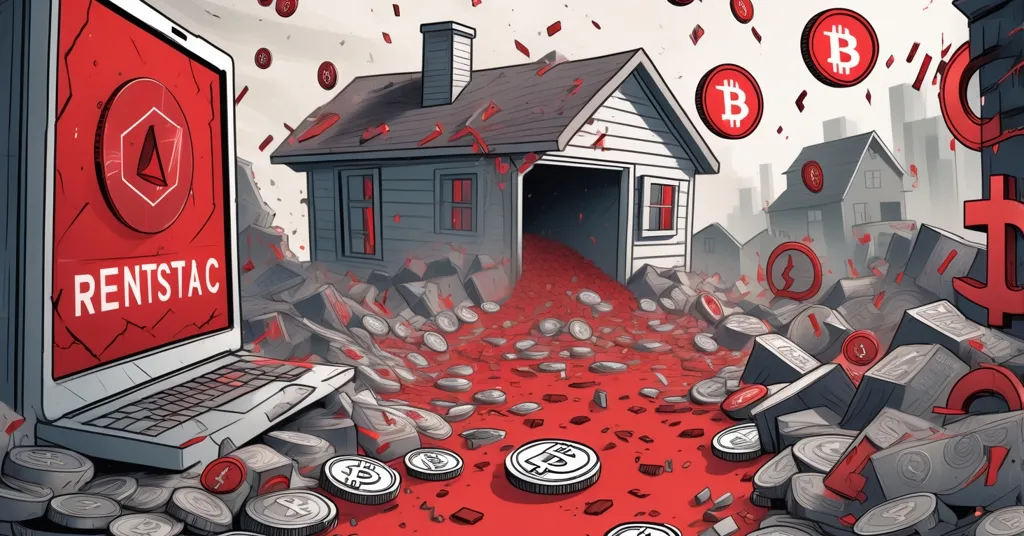Crypto Crash Wipes Out $400M: Can RentStac Offer Real Stability?

Crypto Market Massacre: $400M Liquidated in 24 Hours—Is RentStac a True Safe Haven?
A catastrophic sell-off has sent shockwaves through the cryptocurrency market this week, with $400 million vanishing in liquidations across major exchanges as 162,000 traders saw their positions implode. Bitcoin, Ethereum, and a slew of altcoins took a brutal beating, while whispers of refuge emerge with projects like RentStac (RNS), a real estate-backed blockchain protocol. But in a market gripped by fear, can such promises hold water, or are they just another mirage?
- Devastating Losses: $400 million in liquidations wiped out over 162,000 leveraged positions in just 24 hours.
- Crash Triggers: U.S. Federal Reserve caution and investor profit-taking ignited the downturn.
- Potential Shelter: RentStac (RNS) pitches stability with real estate ties, raising $400,000 in presale.
Let’s tear into the chaos of this market crash, unpack why it stings so bad, and scrutinize whether RentStac’s shiny offer is the lifeboat investors need—or a cleverly disguised anchor. We’re diving deep into the facts, the risks, and the hard lessons for both greenhorns and crypto OGs.
Market Meltdown: A $400M Wake-Up Call
The crypto space turned into a slaughterhouse this week as Bitcoin (BTC), Ethereum (ETH), and countless altcoins plummeted in value. The damage was staggering: $400 million in forced liquidations across platforms like Binance and Coinbase, with over 162,000 leveraged positions erased in a mere 24 hours, as reported in a recent analysis of the market crash. Prices for Bitcoin reportedly dipped by over 5%, while Ethereum saw similar gut-wrenching drops, though exact figures vary by exchange and timeframe. The speed and scale of this wipeout left even seasoned traders stunned, with social media buzzing over the sheer carnage.
What sparked this firestorm? Two main culprits emerge from the rubble. First, cautious remarks from the U.S. Federal Reserve—likely tied to inflation concerns or hints at tighter monetary policy—spooked risk asset markets, including crypto. Second, a wave of profit-taking swept through as jittery investors cashed out gains to avoid deeper losses. It’s a familiar one-two punch: macro fears from traditional finance collide with the herd mentality of crypto speculators, and the result is a cascading nightmare. Even Bitcoin, the supposed bastion of decentralized resilience, couldn’t escape the panic. We’ve seen this play out before—think the Terra-LUNA disaster of 2022 or the flash crashes of 2021—and yet, the same mistakes keep repeating. It’s almost poetic, if it weren’t so damn painful.
Why Crashes Hit Like a Freight Train
The sting of this market rout cuts deepest for leveraged traders, the high-rollers of the crypto world. Leveraged trading means borrowing money to amplify your bets—if the market moves your way, profits soar; if it tanks, losses snowball, and exchanges liquidate your assets to cover the debt. It’s like playing poker with a loan shark breathing down your neck—one bad hand, and you’re out. This week’s $400 million bloodbath showed just how fast that reckoning comes, with thousands of overconfident speculators learning the hard way that volatility is crypto’s middle name.
These events aren’t just personal disasters; they ripple through the ecosystem. Massive liquidations scare off new investors, who see headlines of wiped-out accounts and think twice about jumping in. Yet, there’s a silver lining for the hardened among us: crashes often purge weak hands and speculative froth, potentially strengthening the market’s foundation over time. Still, that’s cold comfort when your portfolio is in the red. The lesson from Terra-LUNA’s implosion or even the 2018 bear market remains unchanged: overexposure in a space this volatile is a gamble, not a strategy. Until risk management becomes gospel, expect more of these brutal wake-up calls.
Fed Fears and Profit Panic: Dissecting the Catalysts
Let’s zoom in on what lit the fuse. The U.S. Federal Reserve’s latest signals—whether about interest rate hikes or curbing inflation—cast a long shadow over risk assets, and crypto is no exception. When central banks tighten the screws, speculative markets like ours feel the squeeze first, as cheap money dries up and investors flee to safer havens. It’s not a new dynamic, but it’s a potent one, reminding us that Bitcoin’s dream of total independence from traditional finance is still just that—a dream, for now.
Layer on top of that the profit-taking frenzy. After recent price rallies, many traders saw an opportunity to lock in gains, especially with Fed uncertainty looming. One sell order begets another, and soon, algorithms and panic amplify the downward spiral. It’s a feedback loop of fear, and leveraged positions are the kindling. This isn’t conspiracy; it’s just human nature in a market that thrives on sentiment. Until crypto matures—or decouples more meaningfully from macro forces—expect these external shocks to keep rattling our cages.
Chasing Stability: The Rise of Real Yield
With traders nursing their wounds from this latest rout, the search for safer ground has kicked into overdrive. Enter “real yield,” a concept gaining traction as an antidote to crypto’s wild swings. Unlike the speculative pumps of memecoins or the dubious returns of some DeFi yield farms, real yield refers to income tied to tangible, real-world operations. Imagine earning a slice of rent from an apartment building paid directly to your blockchain wallet—that’s real yield, grounded in actual cash flow rather than hoping a token’s price moons overnight.
But let’s not get carried away with optimism. The idea of stability in crypto sounds like a warm blanket, yet the space has a graveyard of “asset-backed” promises that crumbled under pressure. Tether’s endless reserve controversies or the early struggles of tokenized platforms like RealT show how tricky it is to bridge blockchain’s chaotic freedom with the slow, regulated world of traditional assets. Execution is everything, and past failures scream for caution. Real yield might be a north star for burned investors, but it’s no guaranteed shield against the market’s storms.
RentStac (RNS) Under the Microscope: Genius or Gimmick?
Stepping into this narrative of stability is RentStac (RNS), a blockchain project pitching itself as a harbor in the storm. Their model is straightforward but intriguing: the RNS token represents fractional ownership in a portfolio of income-generating rental properties. Real tenants pay real rent, and that cash flow is distributed to token holders as on-chain yield. Think of it as crowdfunding a house—your tokens act like tiny shares of the property, earning you a cut of the rent without needing to own the whole building. Unlike some altcoin riding a viral hype wave, RentStac claims its value is anchored by physical assets, theoretically insulating it from crypto’s bipolar mood swings.
Their presale has turned heads, raising over $400,000 toward a $1 million goal, sweetened by a limited-time 100% token bonus. Put in $500, and you get $1,000 worth of RNS tokens—a juicy carrot for anyone spooked by the market’s recent carnage. Real estate, historically a bedrock of wealth-building, paired with blockchain’s ability to democratize access, feels like a match made in heaven. Owning a sliver of a rental unit in a bustling city without a millionaire’s bankroll? That’s the kind of disruption decentralization champions.
But let’s slam the brakes on the hype train. Tokenized real estate isn’t a novel idea, and it’s fraught with challenges. How liquid are these tokens if the secondary market dries up? Where are these properties located, and can ownership deeds be verified on-chain? Who audits the rent payouts to ensure they’re not just numbers on a screen? Regulatory roadblocks loom large—governments worldwide are still figuring out how to handle crypto assets tied to physical property, and a crackdown could derail such projects overnight. And that 100% bonus? Either it’s the deal of the century or a classic “pump before dump” tactic—take your pick. Without hard data on RentStac’s team, roadmap, or asset portfolio (details their whitepaper or website should clarify), blind investment is a fool’s errand. Do the legwork before you dive in.
Volatility is back.
No kidding. This week’s implosion hammered that truth home. RentStac’s bold claim stands out amid the noise:
While other tokens are at the mercy of market news and speculative trends, RentStac’s value is grounded in tangible assets.
It’s a hell of a pitch, but one that demands ironclad proof. Grounded value is only as good as the foundation beneath it.
Regulatory Roadblocks: A Looming Threat for RNS
One of RentStac’s biggest hurdles isn’t tech or market sentiment—it’s the long arm of the law. Tokenized real estate operates in a gray zone where crypto’s permissionless ethos clashes with real-world property regulations. Are these tokens securities under SEC scrutiny? How do international property laws apply when ownership is fractionalized across a blockchain? Past projects in this niche have stumbled hard over compliance—some faced fines, others shut down entirely. If RentStac can’t navigate this minefield, no amount of rental yield will save it. Investors betting on this as a safe haven need to factor in the very unsafe reality of regulatory whiplash.
Bitcoin’s Throne: Why BTC Still Rules, But Niches Exist
As someone who often leans Bitcoin maximalist, I’ll always champion BTC as the heart of this financial revolution. It’s the hardest money humanity has forged, a defiant stand against fiat inflation, and a blueprint for personal sovereignty. But let’s be honest—Bitcoin’s volatility, as painfully evident this week, is baked into its DNA. It’s not built to be a stablecoin or a yield generator; it’s a store of value and a settlement layer for a decentralized future. That leaves gaps for projects like RentStac or Ethereum’s sprawling DeFi experiments to address use cases BTC doesn’t touch. If RNS can prove its model—delivering real-world returns without collapsing under legal or operational strain—it could be a complementary piece in a diversified crypto stack. Disrupting closed-off industries like real estate with blockchain’s open access? That’s a fight even the most diehard BTC purist can cheer for.
What’s Next for the Market?
This week’s rout won’t be the end of crypto—far from it. Markets recover, driven by the relentless innovation of blockchain tech and the unshakable belief in decentralized finance. Signals to watch include upcoming Federal Reserve meetings, which could either ease or exacerbate macro pressure, and longer-term catalysts like Bitcoin’s next halving, expected to tighten supply and potentially spark bullish momentum. But recovery doesn’t erase risk. Crashes like this can spook mainstream adoption, yet they also refine the space by shaking out speculative excess. The question is whether we’re learning from these cycles or just repeating history with fancier toys. Keep your eyes peeled on liquidation data via platforms like Coinglass to spot future tremors, and don’t let short-term panic cloud the bigger picture.
Key Questions and Takeaways on the Crypto Crash and RentStac’s Promise
- What caused the $400 million liquidation crash in crypto markets?
Cautious U.S. Federal Reserve statements on monetary policy and a rush of profit-taking by investors triggered a vicious sell-off, hammering Bitcoin, Ethereum, and altcoins, with over 162,000 leveraged positions erased in 24 hours. - Why do leveraged traders suffer most in these downturns?
Leveraged trading amplifies gains and losses by using borrowed funds, so a small price drop can wipe out entire positions as exchanges liquidate assets to cover debts, as seen in this brutal market wipeout. - What’s fueling interest in real yield crypto projects?
Investors, weary of crypto’s unpredictable swings, are seeking returns tied to real-world operations like rental income, hoping to shield capital from speculative volatility. - How does RentStac (RNS) aim to provide stability?
RentStac ties its RNS token to fractional ownership of rental properties, distributing tenant payments as on-chain yield, rooting its value in physical assets rather than market hype. - Is RentStac’s 100% presale bonus a safe crypto investment?
While enticing, such bonuses can mask risky tokenomics or marketing ploys; scrutinize RentStac’s asset backing, team credibility, and legal framework—check their whitepaper or site—before committing funds. - Can tokenized real estate survive regulatory scrutiny?
Projects like RentStac face significant legal hurdles as governments grapple with classifying crypto-property hybrids, and past failures in this space highlight the risk of compliance crackdowns.
We’re cutting through the panic and promises to bring you the unfiltered truth about crypto’s latest gut punch and the shiny alternatives vying for your attention. This $400 million liquidation hurts, but it’s also a chance to reassess what holds real value—be it Bitcoin’s unshakable vision or the unproven potential of something like RentStac. Stay sharp, question everything, and let’s keep driving this decentralized revolution forward, one hard lesson at a time.



